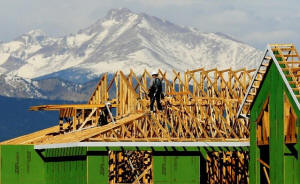|
U.S. housing starts hurt
by weakness in multi-family units
 Send a link to a friend
Send a link to a friend
 [June 18, 2016]
By Lucia Mutikani [June 18, 2016]
By Lucia Mutikani
WASHINGTON (Reuters) - U.S. housing starts
slipped in May as the construction of multi-family housing units
dropped, but further gains in building permits signaled a rebound that
would support economic growth in the second quarter.
Groundbreaking fell 0.3 percent to a seasonally adjusted annual pace
of 1.16 million units, the Commerce Department said on Friday. May's
decline followed a 4.9 percent surge in April. Building permits rose
0.7 percent to a 1.14-million unit rate in May.
"Another month of gains in building permits coupled with near record
low mortgage rates provide opportunity for a bounce back," said Bill
Banfield, vice president at Quicken Loans in Detroit.
Though the pace of home building has slowed after a brisk first
quarter, housing remains a pillar of strength for the economy.
Residential construction added almost six-tenths of a percentage
point to first-quarter gross domestic product, the biggest
contribution in more than three years.
The economy grew at a 0.8 percent annualized rate in the first
quarter. The Atlanta Federal Reserve left its growth forecast for
the second quarter unchanged at a 2.8 percent pace after Friday's
housing starts data.
Economists polled by Reuters had forecast housing starts falling to
a 1.15 million-unit pace last month.

The S&P homebuilding index <.SPLRCHOME> rose 1.21 percent,
outperforming a broadly weaker U.S. stock market. Shares in the
nation's largest homebuilder, D.R. Horton Inc <DHI.N>, advanced 1.31
percent and Lennar Corp <LEN.N> gained 1.0 percent. Luxury
homebuilder Toll Brothers rallied 1.82 percent.
Prices for U.S. government debt fell and the dollar <.DXY> was
trading lower against a basket of currencies.
GAINS IN THE SOUTH
Groundbreaking on single-family homes, the largest segment of the
market, rose 0.3 percent to a 764,000-unit pace last month.
Single-family starts in the American South, where most of the home
building takes place, rose 2.6 percent to their highest level since
December 2007.
Single-family starts in the Northeast region surged 12.7 percent. In
the West, groundbreaking on single-family housing projects rose 1.9
percent. But single-family starts in the Midwest tumbled 14.7
percent to a six-month low.
Further gains in single-family starts are likely after a survey on
Thursday showed confidence among home builders rose to a five-month
high in June amid optimism over sales and buyer traffic. But
single-family home construction continues to run ahead of permits,
which could limit the rise in the short term.
[to top of second column] |

Workers install a roof on a multi-family building against the
backdrop of the Rocky Mountains in Broomfield, Colorado February 19,
2014. REUTERS/Rick Wilking

Housing starts for the volatile multi-family segment fell 1.2 percent to a
400,000-unit pace last month, following an 11.9 percent jump in April. The
multi-family segment of the market continues to be supported by strong demand
for rental accommodation as some Americans remain wary of owning homes years
after the housing market collapse.
Multi-family home construction is also being aided by rising household formation
as a fairly strong labor market increases employment opportunities for young
adults.
"There is some evidence of a pullback in multi-family activity from very
elevated levels seen in the summer of last year, but the strength of the rents
data in the inflation report suggests that this is not a product of
overbuilding," said John Ryding, chief economist at RDQ Economics in New York.
The government reported on Thursday that rents in May posted their biggest gain
since February 2007.
Permits for the construction of single-family homes fell 2.0 percent last month
to a 726,000-unit rate. But single-family permits in the South rose 0.8 percent
to a five-month high. Multi-family building permits increased 5.9 percent to a
412,000-unit pace in May.
"We think the signals from the recent permits data, which are forward looking,
are more indicative of the underlying trends. We look for continued improvement
related to single-family units over time but some cooling in the multifamily
data," said Daniel Silver, an economist at JPMorgan in New York.
(Reporting by Lucia Mutikani; Editing by Paul Simao)
[© 2016 Thomson Reuters. All rights
reserved.] Copyright 2016 Reuters. All rights reserved. This material may not be published,
broadcast, rewritten or redistributed.
 |